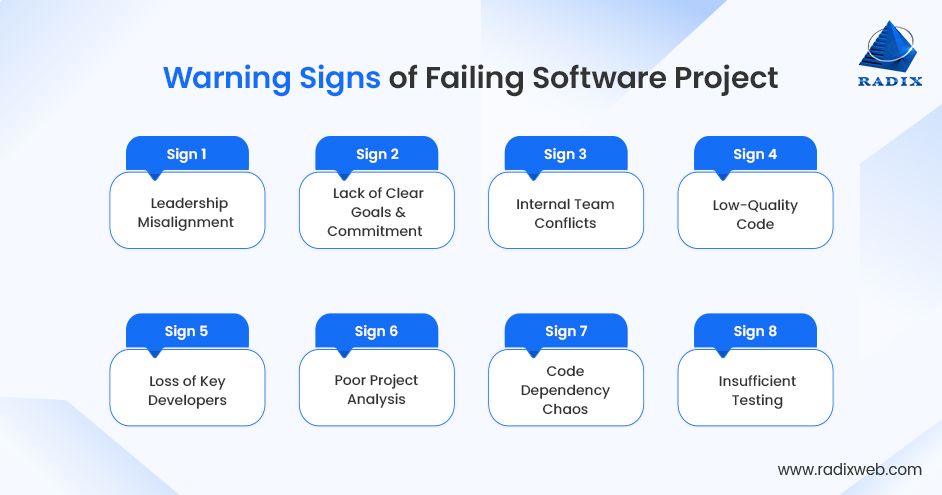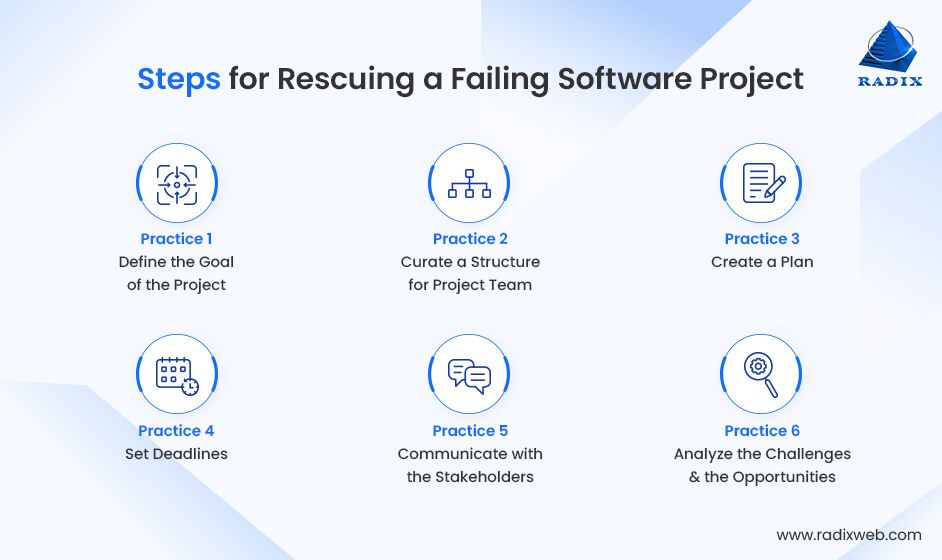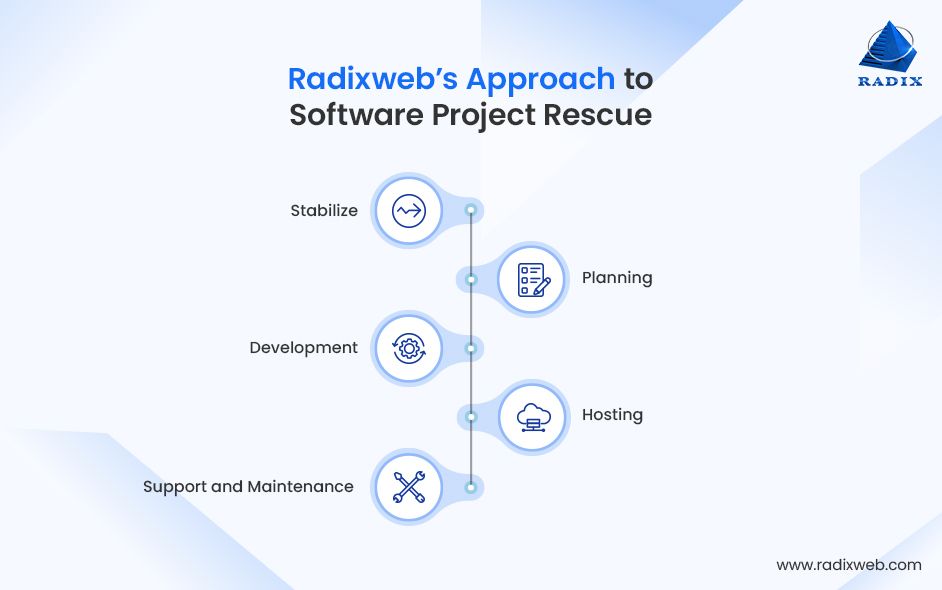Read More

Discover what’s next for AI in healthcare in 2026 - Get Access to the Full Report
Ultimate Guide To Rescue A Failing Software Project

Maitray Gadhavi

On This Page
Quick Summary: Software failure is more common (and costly!) than most businesses would like to admit. However, failure isn’t final. With timely diagnosis and recovery tactics, derailed software projects can be brought back on track. In this guide, we look at the early signs of software project trouble and what it really takes to recover. Alongside our experience at Radixweb, we’ve included reflections from CEOs, CTOs, and product heads who’ve seen both sides of project rescue. Their stories offer clarity, caution, and, most importantly, practical ways forward.
On average, software development costs can range between $25,000 to $250,000.
If you are investing so much money (and time!) into something, you’d naturally want it to be successful, right?
But the odds are often stacked against you.
- 64% of software projects miss deadlines.
- Large IT projects usually operate 45% over budget.
- Bigger software projects are known to deliver 56% less value than expected.
Software statistics like these and many more prove that software project failure is common. And when it happens, project post-mortem meetings are held and a list of reasons are highlighted. That, however, does little to recover the time, money, and effort that was invested in the software project.
Therefore, what’s important is to identify the causes of software project failure beforehand and rescue the project in time.
In this blog, we will help you do just that. We will start with some tell-tale signs of impending project failure and then share steps to rescue a failing project.
So dive right in.
What Are Software Projects?
A software project refers to the entire process of developing software solutions. It covers everything from requirement gathering to testing, deploying and maintaining the software.
The project is completed within a predetermined timeframe using set development and project management approaches to produce the desired software product with the help of software development services. Now that you know what a software project is, let us move on to another crucial aspect.
What is Software Project Rescue?
Software project rescue is when a project is bought back on board with as minimal impact on the current project budget and timetable as possible. Project rescue services can help you with the support you need to complete your project by analyzing the present scenario and helping you in the best possible ways to get positive changes. It is usually done by software refactoring, with the help of a product management team.
What causes a software project to fail?
There are dozens of reasons that can cause software project failure. Even if you hire dedicated developers or outsource software development, things can go wrong. Maybe the developers aren’t skilled enough, the development team is experienced, the execution is poor, or the tech choices aren’t correct.
Other than that, a software project also might fail if it is not built keeping business goals in mind, the project is poorly planned, or the deliverables aren’t decided beforehand.
Another common reason why projects fail is overambition. You may be trying to solve too many problems at once or create a “perfect” solution. As David Chen, VP & CTO of DataNumen, shares:
"In the past, I tried to develop a universal file repair tool that would support all kinds of file formats. Over time, the project became more and more complex, while the recovery rate for each file format became lower and lower. In the end, the project failed due to overwhelming complexity. This experience taught me that it is nearly impossible to design a one-size-fits-all solution".
However, this doesn’t mean every project is destined to fail. In fact, you can also save a failing project, if you address the concerns early on. And you can only do that if you know what are common signs of a failing project.
Signs of a Failing Project
Here are some warning signs of a failing software project that you should look out for:

Sign 1. Leadership Misalignment
When business leaders and tech teams don’t share a unified vision, decisions become fragmented. That’s when software product development priorities shift erratically. This misalignment results in unclear objectives, scope creep, and contradictory directives. Ultimately, all this steers the project off course.
As Valentin Radu, CEO of Omniconvert, reflects from experience:
"One of the most important insights I've gained from a failed software initiative is the critical need to align goals between stakeholders and the development team from the outset. During an extensive eCommerce endeavor, I underestimated how vital clear dialogue was, resulting in conflicting priorities and missed milestones. This experience taught me to consistently emphasize openness and craft comprehensive project plans before coding begins."
Sign 2. Lack of Clear Goals and Commitment
Projects without clearly defined goals lack purpose and direction. When stakeholders assume objectives are “obvious,” teams make conflicting assumptions, leading to misaligned work and inconsistent progress. Without a solid commitment to specific outcomes, motivation and accountability quickly erode.
Sign 3. Internal Team Conflicts
Poor collaboration, unresolved disagreements, or ego clashes within the team can derail progress. Even if personal relationships remain polite, a lack of cooperation in tasks, feedback, or priorities can lead to bottlenecks and fragmentation.
In fact, irrespective of the software project management methodologies used, lack of internal cooperation will eventually slow down or even stall the entire project.
Sign 4. Low-Quality Code
Messy, poorly structured, or hastily written code leads to fragile systems that break easily and are difficult to maintain. Often the result of choosing speed over quality or outsourcing custom software development services without scrutiny, bad code snowballs into technical debt, bugs, and missed deadlines. And it makes recovery more difficult the longer it’s left unchecked.
Sign 5. Loss of Key Developers
If external partners vanish mid-project or internal team members exit without proper knowledge transfer, the project suffers. Institutional memory disappears, unfinished components pile up, and handovers become chaotic. This leaves the remaining teams scrambling to rebuild or reverse engineer.
Sign 6. Poor Project Analysis
Failing to deeply understand business needs, user expectations, or technical requirements often leads to flawed assumptions. This results in building features no one needs or overlooking critical functionality. Raju Dandigam, an engineering manager, learned this firsthand:
"The most challenging lesson I learned involved developing an advanced internal dashboard which turned out to be useless to everyone. The team concentrated on creating elaborate charts and features instead of determining what support team members required for their daily operations. The project was implemented in silence, and it received no adoption despite all the work invested."
Sign 7. Code Dependency Chaos
Heavy reliance on undocumented libraries, outdated tools, or third-party components with unclear licenses can cripple progress. When these dependencies aren’t evaluated early, they become hidden liabilities that block integration, scalability, or even legal deployment. This is one of the things that you should consider when choosing a software development partner.
Sign 8. Insufficient Testing
Rushed or inadequate testing leaves bugs undetected and usability issues unresolved. Whether it’s over-testing irrelevant paths or skipping essential QA steps, the result is the same. Unstable releases, user frustration, and mounting rework that drains the project’s momentum.
How to Rescue a Failing Software Project?
Now that we’ve identified the most common signs of a failing software project, the next step is turning those insights into action. Recovery isn’t just possible. It’s practical with the right approach.
The foundation? Clear goals, realistic timelines, and a dedicated development team that understands the mission. But structure alone isn’t enough.
To prevent those failure signs from resurfacing, you need open communication, iterative planning, and a delivery model that adapts with you. That’s where Agile and DevOps as a Service come in and enable continuous integration, quicker fixes, and a more resilient project lifecycle.
Let’s explore the smart practices that help bring struggling projects back on track.

Practice 1 - Define the Goal of the Project
Every successful software project starts with a clearly defined goal. Without a specific objective, it’s easy to lose focus, motivation, and direction along the way. Setting project-oriented goals helps keep the team aligned and ensures every effort is tied to a meaningful outcome. Here are some questions you should ask first:
- What is it that you want to achieve?
- How will you evaluate your development?
- What are the repercussions of failing to achieve your objectives?
- Are your goals related to time?
Once your goals are set, stay focused on them. Losing sight of clear objectives is a fast track to project drift.
Practice 2 - Curate a Structure for Project Team
Establishing a clear team structure is vital for a successful software project. A well-defined system ensures timely delivery, helps monitor the budget, and facilitates effective resource allocation. To build a strong team structure, consider the following:
- Define the KPls
- Assign tasks to everyone
- Create clear communication between the team members
- Remember to hold people responsible for their duties
Practice 3 - Create a Plan
Planning is one of the most critical tasks for any software project's success. Without planning, it becomes difficult to analyze what needs to be done, by whom, and how much work is required. Collecting these details and planning prior will help you know when the project will be completed. Include the following to build an excellent plan:
- An inventory of resources needed to finish the job
- A list of risks in hand
- Estimation of work that'll be necessary
- A schedule that identifies when each task should be completed
Practice 4 - Set Deadlines
Setting realistic deadlines helps keep your project on track and minimizes unexpected issues. When everyone knows how much time is allocated for each task, they can plan and execute more effectively.
Unrealistic deadlines can lead to frustration and burnout, while overly generous ones may slow progress and reduce focus. Deadlines should be ambitious yet achievable.
Remember, timelines may need adjustment as circumstances evolve. If you find the project falling behind, take a step back to re-evaluate your plan. This proactive approach is key to successful project management and one of the most effective practices in modern software development methodologies.
Practice 5 - Communicate with the Stakeholders
Poor communication is one of the top contributors to project derailment. That’s why proactive dialogue, aligned expectations, and ongoing feedback are critical. Roberto Rusconi, Head of Product at Docsity, shares:
"Every team member is encouraged to voice concerns promptly, improving the project's adaptability. By turning that failure into a stepping stone, I've become more proactive in communication, greatly reducing the risk of similar issues in future endeavors. Such practical frameworks have not only accelerated project success but also built a culture of trust and innovation within the team."
Clear and precise communication with stakeholders will help everyone comprehend what is required and how to collaborate to accomplish the project’s objective. A few important things to keep in mind are:
- While communicating, be clear about what you want from them.
- Make sure you understand their requirements and expectations.
- Be ready to respond to any inquiries.
Practice 6 - Analyze the Challenges and the Opportunities
Successful project execution starts with being prepared. Not just for risks, but opportunities too. Stay aligned on the project’s scope, ensure your team understands the goals, and maintain a clear plan for delivery.
Many software projects fail because potential hurdles and possibilities were never examined early on. By proactively identifying risks and recognizing growth opportunities, teams can make better-informed decisions. Even if it means adapting the original plan.
Don’t hesitate to course-correct when needed. Involve your team in evaluating alternative approaches and leverage their insights to unlock value. A well-informed, flexible mindset helps you reduce stress, improve execution, and build solutions that truly serve both users and developers.
Rescue vs Rebuild: Which is better for failing software?
When a software project starts falling apart, one of the hardest decisions is whether to revive it or rebuild from scratch. There’s no one-size-fits-all answer, but a clear-eyed evaluation can guide the right call.
Start by asking yourself:
- Does the project still serve a critical business goal or deliver meaningful ROI?
- Do you have the right team, time, and budget to stabilize and fix what’s broken?
- Is the existing codebase robust enough to evolve—or is it holding your project hostage?
- Would a fresh build deliver results faster, with fewer compromises?
If the core architecture is solid and the issues are process-related (like unclear goals, poor communication, or missed deadlines!) then a rescue mission might be the fastest path to value. With the right development partner, even troubled projects can bounce back.
On the other hand, if the technology is outdated, the vision has changed, or fixing the mess costs more than starting over, a clean slate is the smarter bet. Rebuilding allows you to apply hard-earned lessons, modernize your stack, and launch with clarity and control.
In the end, the best decision is the one that minimizes waste—and maximizes momentum.
How does the software rescue process work?
Regardless of what led to software project failure, as a leading enterprise software development company, at Radixweb, we follow a step-by-step process to help rescue the project. We have explained our software rescue process below:

Step 1 - Stabilize
Our professional rescue team will analyze your project landscape and the delivery requirements.
Step 2 - Planning
After analyzing, they will create a pragmatic, achievable product management roadmap for you to meet your goals quickly.
Step 3 - Development
We will then develop your software with a team of developers, project managers, business analysts, engineers for infrastructure, and testers.
Step 4 - Hosting
We will analyze where and how to host your solution to help you make the best out of your software project.
Step 5 - Support and Maintenance
After project deployment, our team is also available to support and maintain your software. This helps resolves any problems, incorporate new features, and train your team on operating and maintaining the solution.
Want to explore these steps in detail? Check out our in-depth software project rescue guide here.
These are a few steps that you can follow for a software project rescue. Plus, the use of software project management best practices can help you stay ahead of the curve.
Bottom LineGetting a failed software project back on track requires a complete analysis of what went wrong and a mindset to adapt. Though failure is bad, your positive mindset and careful planning can help you bounce back in this scenario. Start by finding the gaps and things that you can repair straightaway. You can add new imperative features, replace source code, and fix errors over time. Alternatively, you can save precious time and resources by collaborating with the seasoned software project rescue team at Radixweb.For the past two decades, we have worked on some of the most challenging rescue project scenarios, saving our clients millions. We can help you bring your project to life again and steer it in that direction. Talk to our experts to see what can be done to bring your derailed project back on track.
Frequently Asked Questions
How long does a typical software project rescue take?
Is it possible to rescue a project developed by another vendor?
How can Agile help in software project recovery?
How do you rebuild team morale in a failing project?
What is a recovery roadmap in software development?
Ready to brush up on something new? We've got more to read right this way.





